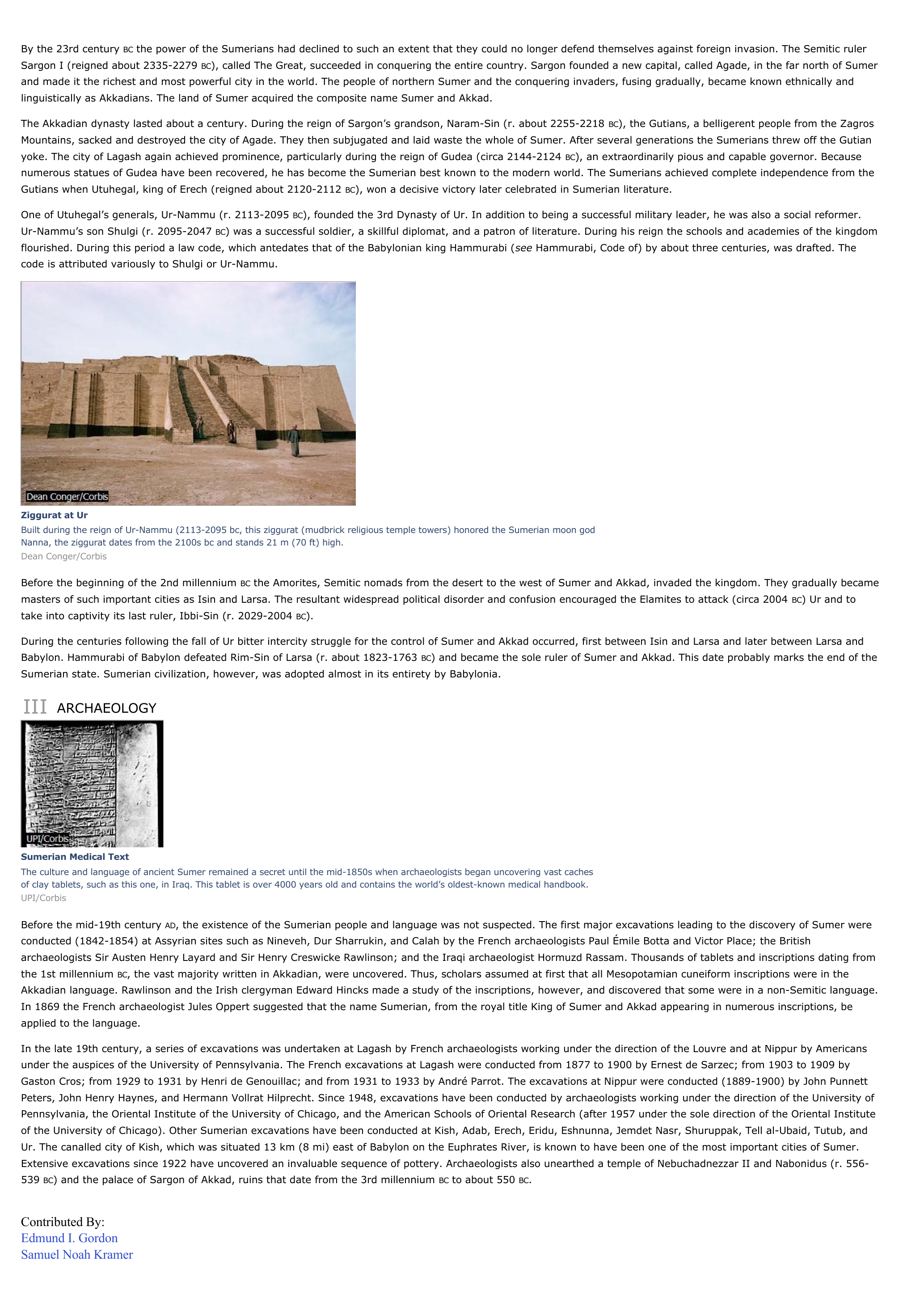Sumer - history.
Publié le 26/05/2013
Extrait du document
«
By the 23rd century BC the power of the Sumerians had declined to such an extent that they could no longer defend themselves against foreign invasion.
The Semitic ruler Sargon I (reigned about 2335-2279 BC), called The Great, succeeded in conquering the entire country.
Sargon founded a new capital, called Agade, in the far north of Sumer and made it the richest and most powerful city in the world.
The people of northern Sumer and the conquering invaders, fusing gradually, became known ethnically andlinguistically as Akkadians.
The land of Sumer acquired the composite name Sumer and Akkad.
The Akkadian dynasty lasted about a century.
During the reign of Sargon’s grandson, Naram-Sin (r.
about 2255-2218 BC), the Gutians, a belligerent people from the Zagros Mountains, sacked and destroyed the city of Agade.
They then subjugated and laid waste the whole of Sumer.
After several generations the Sumerians threw off the Gutianyoke.
The city of Lagash again achieved prominence, particularly during the reign of Gudea (circa 2144-2124 BC), an extraordinarily pious and capable governor.
Because numerous statues of Gudea have been recovered, he has become the Sumerian best known to the modern world.
The Sumerians achieved complete independence from theGutians when Utuhegal, king of Erech (reigned about 2120-2112 BC), won a decisive victory later celebrated in Sumerian literature.
One of Utuhegal’s generals, Ur-Nammu (r.
2113-2095 BC), founded the 3rd Dynasty of Ur.
In addition to being a successful military leader, he was also a social reformer. Ur-Nammu’s son Shulgi (r.
2095-2047 BC) was a successful soldier, a skillful diplomat, and a patron of literature.
During his reign the schools and academies of the kingdom flourished.
During this period a law code, which antedates that of the Babylonian king Hammurabi ( see Hammurabi, Code of) by about three centuries, was drafted.
The code is attributed variously to Shulgi or Ur-Nammu.
Ziggurat at UrBuilt during the reign of Ur-Nammu (2113-2095 bc, this ziggurat (mudbrick religious temple towers) honored the Sumerian moon godNanna, the ziggurat dates from the 2100s bc and stands 21 m (70 ft) high.Dean Conger/Corbis
Before the beginning of the 2nd millennium BC the Amorites, Semitic nomads from the desert to the west of Sumer and Akkad, invaded the kingdom.
They gradually became masters of such important cities as Isin and Larsa.
The resultant widespread political disorder and confusion encouraged the Elamites to attack (circa 2004 BC) Ur and to take into captivity its last ruler, Ibbi-Sin (r.
2029-2004 BC).
During the centuries following the fall of Ur bitter intercity struggle for the control of Sumer and Akkad occurred, first between Isin and Larsa and later between Larsa andBabylon.
Hammurabi of Babylon defeated Rim-Sin of Larsa (r.
about 1823-1763 BC) and became the sole ruler of Sumer and Akkad.
This date probably marks the end of the Sumerian state.
Sumerian civilization, however, was adopted almost in its entirety by Babylonia.
III ARCHAEOLOGY
Sumerian Medical TextThe culture and language of ancient Sumer remained a secret until the mid-1850s when archaeologists began uncovering vast cachesof clay tablets, such as this one, in Iraq.
This tablet is over 4000 years old and contains the world’s oldest-known medical handbook.UPI/Corbis
Before the mid-19th century AD, the existence of the Sumerian people and language was not suspected.
The first major excavations leading to the discovery of Sumer were conducted (1842-1854) at Assyrian sites such as Nineveh, Dur Sharrukin, and Calah by the French archaeologists Paul Émile Botta and Victor Place; the Britisharchaeologists Sir Austen Henry Layard and Sir Henry Creswicke Rawlinson; and the Iraqi archaeologist Hormuzd Rassam.
Thousands of tablets and inscriptions dating fromthe 1st millennium BC, the vast majority written in Akkadian, were uncovered.
Thus, scholars assumed at first that all Mesopotamian cuneiform inscriptions were in the Akkadian language.
Rawlinson and the Irish clergyman Edward Hincks made a study of the inscriptions, however, and discovered that some were in a non-Semitic language.In 1869 the French archaeologist Jules Oppert suggested that the name Sumerian, from the royal title King of Sumer and Akkad appearing in numerous inscriptions, beapplied to the language.
In the late 19th century, a series of excavations was undertaken at Lagash by French archaeologists working under the direction of the Louvre and at Nippur by Americansunder the auspices of the University of Pennsylvania.
The French excavations at Lagash were conducted from 1877 to 1900 by Ernest de Sarzec; from 1903 to 1909 byGaston Cros; from 1929 to 1931 by Henri de Genouillac; and from 1931 to 1933 by André Parrot.
The excavations at Nippur were conducted (1889-1900) by John PunnettPeters, John Henry Haynes, and Hermann Vollrat Hilprecht.
Since 1948, excavations have been conducted by archaeologists working under the direction of the University ofPennsylvania, the Oriental Institute of the University of Chicago, and the American Schools of Oriental Research (after 1957 under the sole direction of the Oriental Instituteof the University of Chicago).
Other Sumerian excavations have been conducted at Kish, Adab, Erech, Eridu, Eshnunna, Jemdet Nasr, Shuruppak, Tell al-Ubaid, Tutub, andUr.
The canalled city of Kish, which was situated 13 km (8 mi) east of Babylon on the Euphrates River, is known to have been one of the most important cities of Sumer.Extensive excavations since 1922 have uncovered an invaluable sequence of pottery.
Archaeologists also unearthed a temple of Nebuchadnezzar II and Nabonidus (r.
556-539 BC) and the palace of Sargon of Akkad, ruins that date from the 3rd millennium BC to about 550 BC.
Contributed By:Edmund I.
GordonSamuel Noah Kramer.
»
↓↓↓ APERÇU DU DOCUMENT ↓↓↓
Liens utiles
- Sumer - History.
- Ideology and Rationality in the History of the Life Sciences
- HISTOIRE DU RÈGNE DE L'EMPEREUR CHARLES-QUINT [The History of the Reign of the Emperor Charles V].
- HISTOIRE DU MONDE [History of the World].
- GRANDISON (L') [The History of sir Charles Grandison]. (résumé)

































